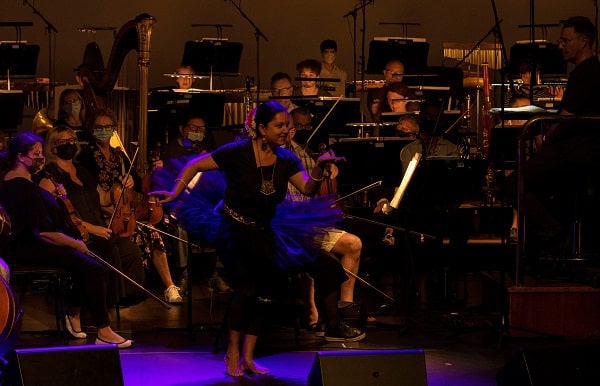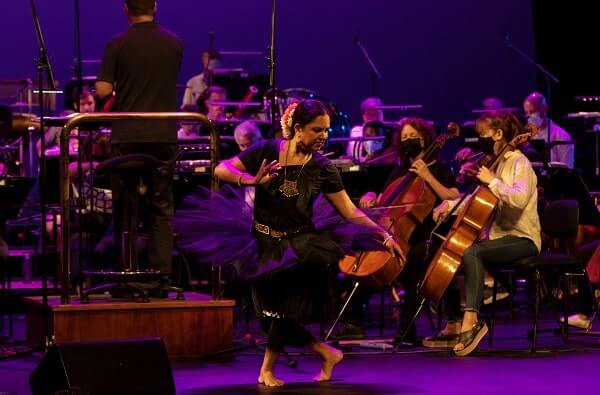On Wednesday 15 February, a world-first collaboration between Sangam and the Melbourne Symphony Orchestra (MSO) will see the stories of Tamil Australians presented in one of Melbourne’s largest cultural venues.
‘Agam (The Interior Landscape)’, a suite for orchestra and Carnatic ensemble, will premiere during the second half of ‘Mosaics – contemporary sounds of Melbourne’, held as part of the MSO’s series of free summer concerts at the Sidney Myer Music Bowl.
Dr Priya Srinivasan, co-artistic director of Sangam, says the performance’s development has been an ongoing conversation since the Sangam Festival’s first iteration with the City of Casey’s Bunjil Place in 2019. Together with Hari Sivanesan and Uthra Vijay, the trio began Sangam to platform South Asian work on Australian stages.
“We did a couple of seasons of Sangam, and Hari had the idea to work with a small orchestra that was local to the South Eastern suburbs,” she says.
“So Robin [Batt], who’s the producer at Bunjil, looked and looked. It took a long time, but one day she said, ‘I have an orchestra you can work with, they’re called the MSO but they’re not exactly local,’ and so it began. We performed with them in 2021, and again in 2022 and each version has been different.”
Dr Srinivasan and Hari Sivanesan are excited to be leading this pioneering collaboration between Carnatic and Western classical music.
“The way we’re engaging Carnatic music with the MSO is quite unique… working with them has meant that we really do tell our stories our own way,” Dr Srinivasan says.
“It’s also a world-first in terms of how you grapple with a colonial institution like the MSO, who are working with us led by Veronica Pardo towards cultural equity.”

Dr Srinivasan notes how such cultural exchange is also a time-honoured process; Muthuswami Dikshitar’s ‘Nottuswaras’ took inspiration from British band tunes in colonial Chennai, and Johann Strauss’ ‘Indianer-Galopp’ was composed to reflect the footwork of dancers visiting Vienna in 1838.
“Research shows that we have been exchanging music and dance ideas for hundreds of years…therefore this project is exposing that hybridity – that Western music is not monolithically Western and Indian music is not monolithically Indian.”
Dr Srinivasan says liminality is a key theme within ‘Agam (The Interior Landscape)’, the title being a reference to classical Tamil poetry.
“I wanted to use the word ‘agam’ but look at it in terms of the interior landscape that migrants, refugees and people of colour have to navigate…how can we reflect the tension between what happens inside us and what happens on the outside.”
Central to the Sangam-MSO project is the melding of text and dance with the music which Dr Srinivasan describes as an anti-colonial perspective, deconstructing the boundaries between artforms.
“Colonial intervention has forced us into these binaries…we really want to rupture that – we want to say, this is our world view: dancers are musicians, musicians are storytellers. It’s about a holistic perspective that doesn’t put us into this arbitrary part and say, ‘this is all you are’.”
She cites Sangam’s First Nations collaborators, including BlakDance, as a key influence on this boundary-breaking approach.
“In my collaborations I’ve worked with a lot of Indigenous artists who break boundaries of form, discipline and content by bringing stories and artistry together…it gave me the courage to try something with our work.”
Whilst excited about working with the MSO, Dr Srinivasan recognises there’s still a long way to go towards systematic change.
“There still needs to be time for an organisation to shift, but they’re trying…they said working with Sangam has been instrumental in changing their thinking on what this work looks like. We’ve started walking on a path, despite our huge power differentials that we’re hopeful will lead to more equitable exchanges as we continue.”

She hopes the collaboration will create opportunities, not only for Sangam but for more marginalised people.
“Hari and I are excited to be working with world class artists such as Uthra Vijay, Sridhar Chari, Pirasannah Thevarajah and so many more dancers and musicians from a wide range of cultural, national, ethnic, religious and disciplinary backgrounds,” she says.
They hope all audiences will resonate with the stories told through the work.
“We want everyone to look at our storytelling, our culture as theirs…we want everyone to be welcomed. Maybe some of them will be uncomfortable at certain moments, at other moments they will laugh, cry, and be uplifted – that is our hope, we want everyone on this journey.”
The MSO Sangam collaboration in ‘Mosaics – contemporary sounds of Melbourne’ will take place on Wednesday 15 February, 7:30pm at the Sidney Myer Music bowl – find out more about this free event.
READ ALSO: The Durga Chronicles by Priya Srinivasan





